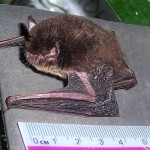
Image: Shutterstock
Male Argentine lake ducks possess — in relation to their body length — the longest penises of any vertebrate.
These large organs may have evolved in an ongoing sexual arms race with the species’ females, who have developed various defenses against unwanted suitors.
Male Argentine lake ducks are far from showy, with mousy brown bodies and black heads, their bright blue beaks their only spot of colour. At only 40 centimetres in length, and weighing just over half a kilogram, they’re far from a force to be reckoned with in the natural world. Yet these small birds unassuming appearance and size belie their importance. In scientific circles it has long been known that male Argentine lake ducks are unusually well equipped when it comes to their genitalia. Penises 20 centimeters long — half as long as a drake’s body — are common for the species.
However, it wasn’t until biologist Kevin McCracken, then at the University of Louisiana, US, and now at the University of Alaska, Fairbanks, published images of a bird he’d caught during the course of his studies in South America that scientists realised how extreme the little duck really is.
The drake that McCracken captured had a penis nearly 44 centimetres long, more or less the length of its entire body. The species already held the record for having the largest genitals in relation to body length of any known vertebrate, but this greatly exceeded that record.
Possession of a penis is far from commonplace among birds. Just three per cent of the 9,600 living species have any external genitalia, such as tinamous, screamers, cracids, ostriches and some ducks. Typically, male and female birds press their cloacal openings — the opening shared by the intestines excretory organs and sex organs — together so that sperm is passed from male to female. The whole process typically takes a few seconds. Evolutionarily, this is interesting, because birds are extended from the extinct reptile — a dinosaur called a theropod — and reptiles typically have a penis, some even have two. The question is whether the few groups of birds with penises are the deviants, or whether the vast majority of birds have changed so much from their ancestors.
A penis means extra weight in the air
There have been many theories put forth to explain the lack of genitalia among most male birds; the most widely held among them posits that it’s a weight-saving measure. When birds began to evolve, it became necessary to shed as much excess weight as possible in order to get into the air. This led to the evolution of light, strong bones and a specialised respiratory system, and it’s conceivable that external genitalia disappeared to save weight too. This theory is not entirely satisfactory, though, because even though many species that have penises are birds that seldom, if ever, fly, many ducks are strong fliers.
Another theory centres on the idea that the male’s penises are specially developed in groups where mating can be difficult to achieve. This applies especially to the ducks, which typically mate in the water, and to ostriches and emus, which have very long legs and need to have unusually good balance in order to mate. But, the tinamous, which also have penises, are small, quail-like birds that do not need any special assistance to mate.
Since McCracken’s discovery of the Argentine lake duck’s unusually long penis, however, researchers have undertaken a series of projects to shed light on what mechanisms really lie behind the evolution of these impressive organs. The answer comes from an expert in evolution and behaviour.
When the pictures of McCrackens duck went out around the world, they proved to be an important source of inspiration for Patricia Brennan, who at the time was a post-doctoral researcher at Yale University, US, and is now a biology professor at the University of Massachusetts, Amherst. Her rather obvious question, one that no one had thought to ask, was this: If this is what the male looks like, what about the female?
“Obviously, you can’t have something like that without some place to put it in. You need a garage to be able to park the car.” Her question led to a long series of investigations that finally explained why a drake 40 centimetres long might need a corkscrew-shaped penis — with spikes — longer than his entire body. When Brennan investigated female anatomy in 16 different waterfowl species (not including the Argentine duck), she discovered that their lower oviducts (the equivalent of the vagina in birds) were not simple channels, but complicated labyrinths filled with side pockets, blind alleys and every imaginable barrier to make unwanted mating more difficult.
The longer the males’ penises, the more complicated the females’ genital canals. To prevent these unwanted sexual encounters some species of females are able to contract their muscles and change the shape of their lower oviducts into corkscrew channels — corkscrew, however, with twists opposite to those found in the drakes’ penises.
A sexual arms race
Brennan also discovered that these unwanted sexual encounters, which are a well-known phenomenon among ducks and can lead to the female’s death, were common precisely among the species with large genitalia, especially among Argentine lake ducks.
All of this points to a kind of arms race between the sexes over the course of the species’ evolution, with their genitalia being the weapons. Males naturally want to father as many offspring as possible while simultaneously preventing other males from reproducing. So the male penis got longer and longer, allowing for sperm to be deposited farther inside the female, and therefore closer to her eggs. The many twists and spikes on the penis are there to scrape out as much of the semen left behind the earlier matings with other males as possible.
Females also want to produce as many offspring as possible, and mate with the strongest and the healthiest males. But as a member of a species where rape is an everyday occurrence, a female must control which male she mates with by developing increasingly complicated hindrances to the males’ increasingly long, complicated genitalia.
If a female is not interested in a particular male, she can guide his penis into one of the many side pockets in her vaginal canal, thus insuring that she does not become pregnant. Or she can close herself off to him by twisting her sexual opening in the opposite direction of his penis, making insertion impossible. So no matter how impressive these male organs are, it appears that for now the female is ahead in the arms race, and she has the last word on whose genes are passed to the next generation.
Marine mammals need large organs for mating in water
Large genitals are common among many vertebrates, especially those that live in the sea. Male blue whales have penises up to two meters long. But the all-time record holders for penis length in relation to body size are members of the crustacean family — the barnacles. Barnacles don’t look like crustaceans at first glance, because all that meets the eye are the small shells they live in, typically attached to pilings, rocks or the sides of ships. Inside the shell is a little shrimplike animal, which will spend its entire adult life without ever leaving. Barnacles are hermaphroditic, in possession of both female and male sex organs, but they typically still mate with other barnacles. Since the shell-bound animals cannot come into direct contact with one another, the penises are many times longer than their bodies — long enough to reach out of one shell and into the shell of another.






